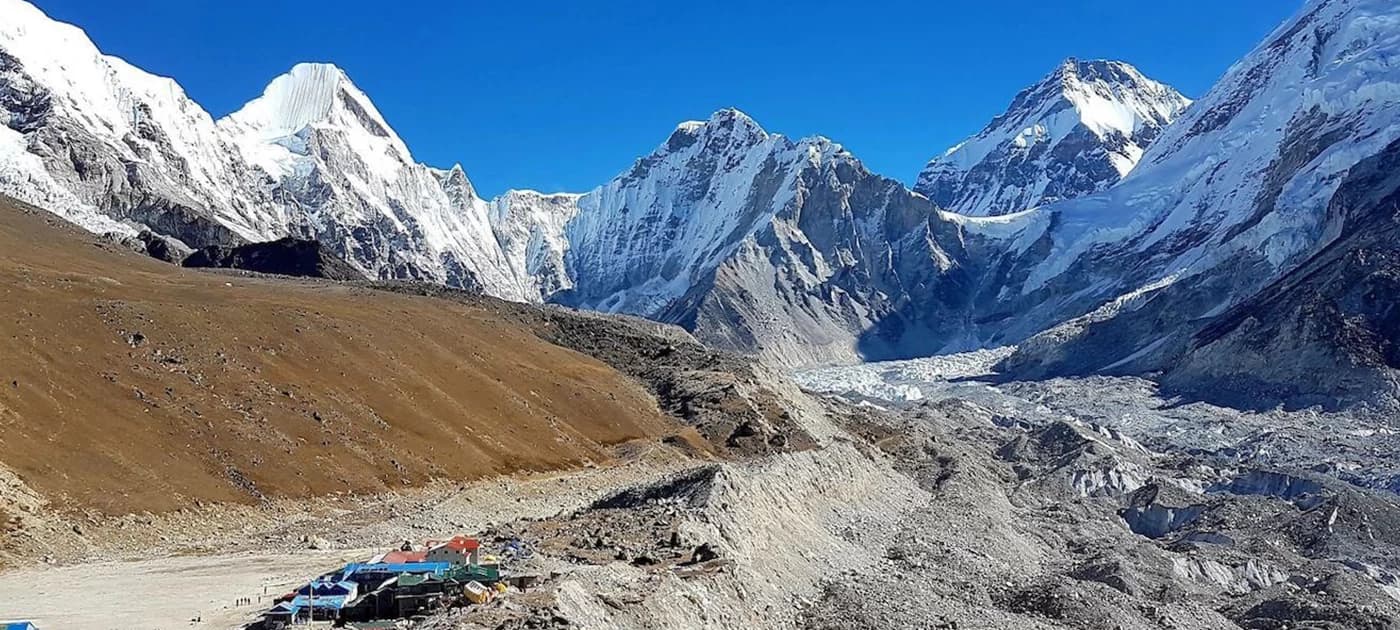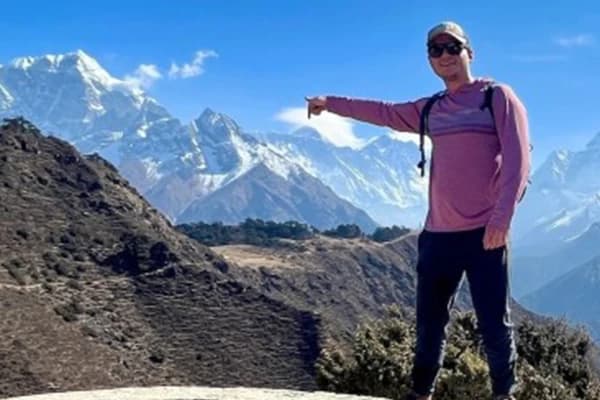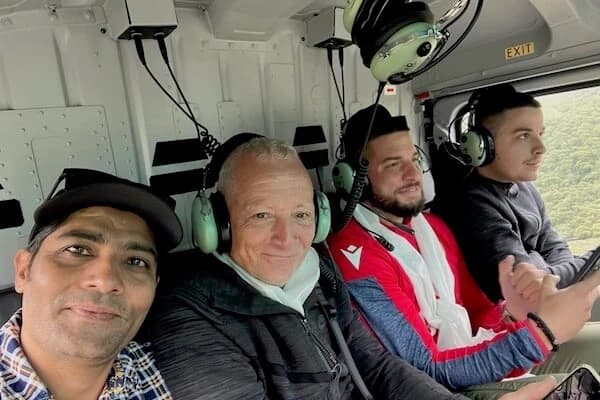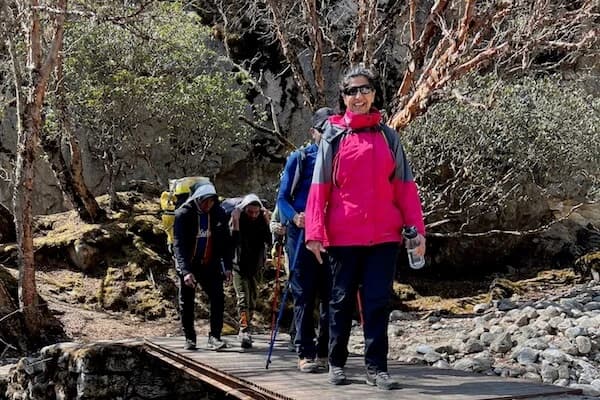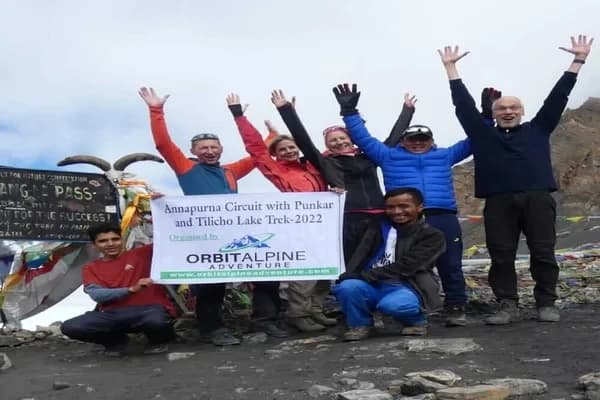The Everest Base Camp Trek with Helicopter Return combines these two in one fantastic and exciting experience. It gets the explorers the best of both worlds, going by foot through the spectacular sceneries in the Himalayas and returning back home very fast by helicopter. This package offers a chance to experience the natural beauty and culture of the Everest region with fabulous mountaineers but enjoy a super picturesque helicopter return.
Top 10 Tips for Everest Base Camp Trek with Helicopter Return
This is a deep study of the rich culture of the Sherpa people, with their peaceful monasteries and astonishing Himalayan sceneries, not just a journey to the base of the world's highest mountain. At the same time serious preparation for high altitudes, rough land, and quickly changing weather. Proper adjustment and development of the physiological regime for high altitudes are aspects that need serious planning. Understanding the logistics for helicopter return and respect for the local customs should also be looked into with great care for this trek.
Let’s discuss the top 10 most important tips to help you complete the Everest Base Camp Trek with Helicopter Return. That confirms you are effectively prepared for one of the most extraordinary experiences of your life.
Adjustment Day is Key to a Safe Trek
Adjustment is the key to a safe and successful Everest Base Camp Trek. Air is getting thinner as we climb high and high, resulting in a decrease in oxygen levels. So, if you do not let your body acclimatize, it will most certainly make you suffer from AMS. It is a disorder that could further increase into more serious conditions like HAPE and HACE, both of which are life-threatening.
Starting from Lukla, at an altitude of 2,860 meters, the normal walk follows a gradual ascent to the base camp at 5,364 meters. Perfect acclimatization will be at its best if a profile of gradually ascending treks can be adopted. Above 3,000 meters, no more than an ascent for an altitude of 300-500 meters per day should be done. Almost equally important is the inclusion of adjustment days in the itinerary. These will allow your body to acclimate to lower oxygen levels while it remains comparatively active with short hikes. These are done with rest days at either Namche Bazaar or Dingboche, 3,440 meters, and 4,410 meters respectively. The other very vital aspect of acclimatization is keeping the body well-hydrated. Symptoms of altitude sickness are much more acute when the body gets dehydrated. Hence, a minimum of 3-4 liters of water on an average daily is important. Lying off the drinking is important, and too much caffeine works similarly to alcohol.

Symptoms of AMS are headache, nausea, dizziness, and breathlessness. You must begin the process of descending at once if the symptoms are continuous and begin to affect or trouble you. Proper acclimatization makes the trek both safe and enjoyable, allowing you to view the joyful beauty of the Everest region without putting one's health at hazard.
Physical Preparation During Everest Base Camp Trek
The Everest Base Camp Trek goes with physical preparation. It includes daily walking for 5-8 hours on rocky land, with steep inclines and great altitudes. Stamina, strength, and durability need to be built at any cost before taking on such adventures.
Begin with cardiovascular fitness, a very energetic part that will enable you to hike for long hours. Running, cycling, swimming, or brisk walking all this exercise will assist you in advancing your heart and lung function. Increase the intensity and time spent on exercises as your fitness levels increase. Work out at least 4-5 times a week and gradually.
Also important, is a mix of strength training, especially in your legs, core, and back. Squats, lunges, step-ups, planks—all those exercises can help you build up the muscle strength needed to find success on the inclines and declines you'll come across on your trek. Safeguard that your upper body is included in your exercise program since the back and shoulders are mainly important in shouldering your daypack.
Work on regular hikes in your training management; this helps you get familiar with the process of trekking. If possible, do some hiking in rough terrain with a loaded backpack. This will be similar to trekking conditions that would test your stamina. Increase the weight and difficulty of the hikes progressively, allowing your body to become well-prepared.
Decided, altitude training might not be available for most people. It would be wise to replace it with stair climbing or working a treadmill on an incline with a weighted backpack. This will get your body familiarized with lower oxygen levels and increased physical demands experienced at higher altitudes.

Building a platform of cardiovascular fitness, strength, and durability will put you in good stead to navigate the physical demands of the Everest Base Camp Trek and help you fully enjoy the experience.
Packing Essentials for Everest Base Camp Trek
The right gear is the key not only to comfort but safety as well. The weather in the Himalayas is quite unpredictable, and the terrain is pretty rough.
What to Pack:
Clothing:
- Base Layers: Thermal tops and bottoms dry to keep you warm
- Mid-Layers: Insulating layers put on over your base layers, such as a fleece jacket or down sweater
- Outer Shell: Rain and wind-protective jacket and pants, with options for waterproofing
- Trekking Pants: Convertible towards the knee, light in weight and breathable
- Warm Accessories: Woollen hats, gloves, and thermal socks are highly recommended for chilly mornings.
Footwear
- Comfortable, broken-in, waterproof boots with good ankle support
- Camp shoes for tea-house
- Sleeping equipment
- Sleeping bag
What is needed is a four-season sleeping bag, which you can adjust as per the season requirement or temperature, personally, it should be rated -15°C (5°F) or colder for chilly evenings on this trek.
Daypack
A good day pack which should let you accommodate 30-40 liters.
- Hydration System: Hydration bladder or water bottles with purification tablets or a small filter.
- Sun Protection: Sunglasses, sunscreen with high SPF, a wide-brimmed hat against UV radiation at high altitudes.
- Personal Hygiene: Toiletries, quick-drying towels, hand sanitizer, baby wipes.
Medical Kit
- First Aid Kit: Blister medication, altitude mountain sickness medication, painkillers, your prescription medications, etc
- Headlamp: for the early start and after dark.
- Trekking Poles: Adjustable poles to help keep the strain off of your knees during incline and decline.
- Snacks: Energy bars, nuts, and dried fruit snacks to provide a quick boost of energy.
With packing and selection of these types of items, you will be prepared to face the rugged trek while being comfortable and safe.
Choosing the Right Season for Everest Base Camp Trek
The perfect time of the year for the Everest Base Camp Trek is of the spirit to have a successful yet enjoyable trek. The trekking time affects numerous aspects, such as the weather conditions, route traffic, and the overall beauty of the scenery.
Spring (March to May): Spring is the best trekking season with good temperature conditions, generally clearer visibility, and blossoming rhododendrons. This is also part of the Everest climbing season, so you're likely to pass or meet excursions aiming to reach the summit. However, the trails can be pretty packed during April and May.
Autumn (September to November): This is the second peak trekking season, with steady weather and clear, crunchy mountain views. Through the post-monsoon period, the sceneries are exciting, characteristically green, and less covered by clouds. Temperatures are cooler compared to spring, but still generally relaxed for trekking. The trails are busy, particularly in October, though the fabulous scenery and reliable weather make it all worthwhile.
Winter: If the cold and even snow do not deter you, walking can be done from December to February. The paths will be much quieter, though, giving a sense of privacy and a much closer connection with the mountains. Temperatures drop awfully at night, and some of the higher-altitude mountain lodges are closed because of the cold temperatures.
Monsoon Season (June to August): The least chosen season for trekking since there is heavy rain, making the paths slippery and muddy. Besides, most of the time, the mountains stay covered by clouds. But on a positive note, this will confirm that you have a different experience since there will be nobody around.
Mental Preparedness for Everest Base Camp Trek
This becomes a highly important factor for the Everest Base Camp Trek since it tests not only your physical strength but also your mental strength. That journey consists of days full of walking, changing weather conditions, and exciting heights and body weakness, making life even more testing on your mind.

Set Realistic Expectations: Just keep in mind that this trek is challenging and each day will not necessarily present itself as easy. You may feel discomfort, tiredness, or even moments when doubts come up. Accepting those challenges as an element of this journey helps keep the focus and positivity in place.
Enjoy the journey: Reaching Everest Base Camp is the final goal, but the journey itself is vital. Savor the beautiful environments, the rich Sherpa culture, and the friendship with fellow trekkers. It helps focus on the small joys along the way.
Doing Mindfulness and Meditations: You should be doing mindfulness or meditation exercises before the trek and also in the trek. This way you will be mindful and keep yourself from getting stressed. The ones inspiring staying present, mostly in the hard sections of the trek or when altitude discomfort arises, are especially useful.
Stay Positive: Your positive attitude is going to be your best friend on the walk. If things get tough, just think of why you started this journey. Share your experiences with co-trekkers, and mutual reassurance does make a lot of difference.
Adaptability and Flexibility: Mountains can get moody, and plans can change. If you are prepared mentally for these changes—such as anxious things like delays due to bad weather or changes in the itinerary—it's then you will manage to face all the conditions easily.
The mental strength and positive attitude developed will make your time spent on journeys not just enjoyable but will also help to get through all the complications that lie ahead on this journey to the Everest Base Camp—a truly inspiring experience of adventure.
Hiring a Guide and Porter
Though it is very achievable to journey independently, a guide and a porter for the Everest Base Camp Trek is an investment that turns out to make a real difference in your trekking experience. Professional help makes your journey so much more: safe, enjoyable, and, in terms of culture, very heartening.
Expert guidance: He or she will provide precious expertise in making the climb a success, navigating complex paths, managing adjustment, and staying safe in impulsive mountain conditions. He is also very knowledgeable in the field of regional history, culture, and traditions and gives important insights that deepen an understanding of the area.
Safety and health: Guides are first-aid trained and familiar with symptoms of altitude sickness. They can make vital decisions and advise on whether to take a rest day or go for a descending walk to have the best experience on the trek. They coordinate releases or medical assistance if need be.
Human Interaction: More interaction with the nearby Sherpa culture is created through local guides. They help one to be able to visit other less-known areas and come into contact with the Sherpa themselves. They can make their ways clear and further guide one towards the less toured areas.
Physical Relief: A porter will carry your heavier gear, leaving you only a day pack to be worried about. This cuts out exhaustion and allows you to enjoy the trek rather than suffer through hardship by carrying a hefty load. It will also lower your risk of injury, mostly on difficult parts of the way.
Contribution to the Local Economy: Likewise, retaining guides and porters contributes directly to the local economic means for the people of Everest essential for supportable income from this type of tourism.
Everest Base Camp Helicopter Return
Helicopter Return to Everest Base Camp is a comfortable yet very well-organized way to do your trek. It saves time, is less fatiguing, and provides remarkable views of the Himalayas from the sky.
Helicopter Return Tips:
• Booking: It is suggested that you book the helicopter return in advance with a trustworthy trekking company. Confirm that it is included in your itinerary, or how much the additional cost might be.
• Weather Conditions: Flights by helicopters are reliant on good weather. Prepare your mind for some likely delay if the climate or the visibility of the land is poor, or if the winds are too strong.
• Altitude and Descent: An enormously quick drop from high altitude into the low-lying, sea-level city of Lukla or Kathmandu can be a shock to the body. Keep hydrated and rest upon arrival, letting your body adjust.
• Scenic Flight: The helicopter flight will give you great scenes above the Everest region; be armed with your camera but also get time to enjoy the place.
Hydration and Nutrition
For keeping energy and to help prevent altitude-related problems it is important to have proper nutrition and hydration.
Nutrition and Hydration Tips:
• High-Calorie Diet: Your body loses much more calories at height. Therefore, include plenty of carbohydrates like rice, pasta, potatoes, and bread accessible from the tea houses in your diet.
• Stay away from junk Food: Do not forget to eat well-balanced meals, with vegetables and protein like lentils, eggs, and meat if found. Although comfort foods/junk food sound tempting.
• Keep Hydrated: Dehydration may raise the symptoms of altitude sickness. Cocaine and alcohol should be avoided since they dehydrate the body. Drink at least 3-4 liters of water every day.
• Snacks: keep foods with you to refresh yourself with instant energy at any time during the trek such as Energy bars, nuts, dried fruits, and chocolates.
Cultural Respect
The journey to the Everest region, populated by the Sherpa community, is replicated in rich culture and deep spiritual traditions, where respect toward locals goes a long way toward making the journey positive.
Tips for Cultural Respect:
• Dress Modestly: Wear suitable clothing that covers the shoulders and knees, especially when visiting monasteries or other religious sites.
• Namaste: Greeting Locals: A traditional Namaste is a slight bow with palms together. It is a way of showing respect to the people that you meet.
• Etiquette in Photography: Always ask for consent before photographing people, especially monks or in religious settings.
• Respect Religious Sites: Walk clockwise around stupa walls and other religious monuments. Don't touch or step over sacred objects.
Preparing for the Unexpected
The Everest Base Camp Trek is an exploration, and just like all other adventures, there come challenges. Flexibility and adaptiveness work under surprising circumstances.
Tips on How to Handle the Unexpected
- Weather Delays: Mountain weather can change randomly. One must be prepared for delays both in flights to and from Lukla or its effect on trekking timetables.
- Altitude Sickness and Other Health Problems: One may be affected by altitude sickness or another health problem. Be ready to shift your plan—descend if you have to.
- Budget Flexibility: Extra cash for extra food, tips, or withdrawal in the event of an emergency.
- Mental Preparedness: Be prepared mentally for hitches. From a positive perspective, accept the uncertainties as part and parcel of your journey and face them with an all-out optimistic heart.
Conclusion
The Everest Base Camp Trek by Helicopter is one such journey that shows an unmatched mixture of challenges, cultural immersion, and natural beauty. Every bit of this walk, from navigating the rocky trails and acclimatizing to the high altitude to enjoying the warmth of Sherpian hospitality and the Himalayan helicopter ride, has been planned in such a way as to leave an impression that would remain on with the tourist.
Full preparation is the key to appreciating the trek and doing it safely. Appropriate adaptation, physical and mental toughness, proper packing, and choice of the right trekking time in a year are the fundamentals of completing the trek successfully. You can hire a guide and a porter, and this will extremely increase your safety, and comfort, and permit you to enjoy the experience without worrying about logistics.
Everest Base Camp Trek with Helicopter Return FAQs
What is the Everest Base Camp Trek with Helicopter Return?
It simply means it is the Everest Base Camp trek, but the return will be via helicopter. In other words for trekkers who take on this trip: they will receive high-altitude trekking experiences and a great deal of scenic views of the Himalayas, but they will be returned quickly by helicopter.
How many days does it take?
Climbing up to Everest Base Camp usually takes 8-12 days. Adding a chopper return will extend your package for a day, but sometimes even flights may get delayed because these kinds of helicopters operate in pretty harsh weather.
3. which is the best Season to Trek?
The perfect time to do the Everest Base Camp is pre-monsoon, from the end of February to May, and post-monsoon, from September to November. The weather is pretty stable during these seasons with a lucid sky and better conditions for trekking.
4. What is the highest altitude on the trek?
Base Camp itself is 5,364 meters or 17,598 feet. The height on the Everest Base Camp trek reaches fairly high: 5,545 meters or 18,192 feet at Kalapatthar.
5. Do I need to be a professional trekker for this?
Though this adds an advantage, it is not necessary. It involves good physical endurance and fitness.
6. What type of gear is required for the trek?
It requires that you pack different layers of clothing; including the same includes a base layer, insulating mid-layers, waterproof outer shell, and warm accessories. A four-season sleeping bag, trekking boots, and daypack is also a must-have.
7. Any chances of altitude sickness?
Yes, altitude sickness is a problem at high altitudes. The best prevention is proper acclimatization, maintaining proper hydration, and a gradual ascent. Look out for any symptoms and prepare to descend if they worsen.
8. How do I book the helicopter return?
You can make a helicopter return arrangement with your trekking agency or tour operator. You are advised to book in advance as a guided trekking package or as an additional extra service package.
9. What if the helicopter flight is delayed or canceled?
Helicopter flights rely on the weather and might get delayed or canceled because of bad visibility or high wind. You should be ready for such delays and you should have a flexible schedule. In such cases, you might need to trek back to Lukla.
10. Can I trek solo, or do I need a guide and porter?
While you can solo trek, it is highly advised to hire a guide and a porter. With their local knowledge in place, they enhance the safety and you get a chance to enjoy the trek more comfortably by carrying your heavy gear.
11. How Do I Prepare Physically for This Trek?
Build endurance with running, biking, or other exercises, and condition the legs, core, and back with some strength exercises. Finally, regular practice of carrying of a loaded backpack while hiking will adapt your body to similar conditions that are encountered while trekking.
12. How to Act if Symptoms of Altitude Sickness Appear?
If you have any of the following conditions, inform the guide at once upon symptom manifestation: headache, dizziness, nausea, shortness of breath, among others. Descend to a lower altitude, and if these symptoms persist or become worse, do seek further medical care.
